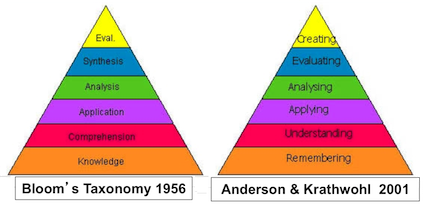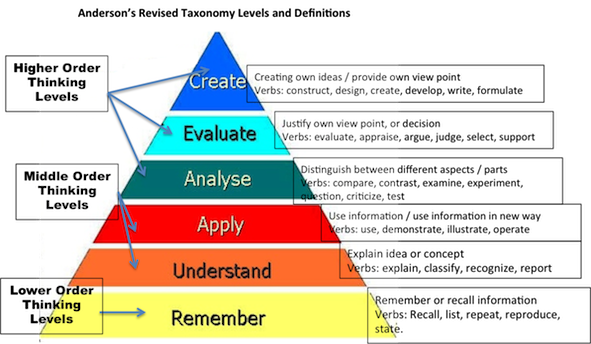We often hear the words critical thinking questions mentioned when investigating teaching ideas and strategies. Incorporated below are practical ideas of how to incorporate the different categories of questioning into your everyday teaching.
The National Curriculum Statements Gr R - 12 among other things, aims to produce learners that are able to solve problems and make decisions using critical and creative thinking, as well as encouraging learners to collect, analyse, organize and critically evaluate information. In the Curriculum Assessment Policy Statements (CAPS) the different subjects use various taxonomies expressing various cognitive classifications or levels which are to be included in the assessment of the subject.
This is a wonderful idea, however if the learners have not been exposed to these types of questions or have not been taught how to answer them, they will find it difficult, even frightening, when confronted with critical thinking questions for the first time in test.
In the CAPS documents various taxonomies with regards to cognitive classifications or levels have been combined and / or used by the different subjects, to be included in the subject's assessment.
All subjects focus on three overall classifications (levels) of cognitive operation or learning:
- Low order
- Middle order
- Higher Order
So where did it begin . . .
Benjamin Bloom, in 1956, categorised and classified thousands of teachers' questions into a taxonomy. He expressed the thought that the higher up the taxonomy one moved with the type of questions being asked and answered, the deeper the learning:
- The lowest level was knowledge (recall of information)
- Comprehension was next (understanding meaning)
- Application followed (apply what has been learnt)
- Analysis, was next (to separate material or concepts into components)
- Synthesis, followed (create new meaning or structure)
- Finally, evaluation (to make informed judgements)
Anderson in 2001, adapted Bloom's idea, replacing the wording, such as knowledge was replaced with remembering. While the higher order levels of evaluation and synthesis were inverted, so that evaluating was seen as the second highest and creating (synthesis) were reflected as the highest order of thinking.
Comparison of Bloom's and Anderson's Taxonomies

Anderson, et al's Changes To Bloom's Taxonomy (Wilson, 2006)
Anderson, Krathwohl, et al. changed Bloom's noun descriptors into verbs. They also interpreted create, as a higher order of thinking, than evaluate.
While a problem-solving taxonomy may be grouped into the areas or classifications of: routine, diagnosis, strategy, interpretation and generation. (Plants, H.L, et al 1980)
Each subject has adapted and interrupted various taxonomies to suit their subject's needs with regard to assessment. (see table below)
Levels of Cognitive Thinking as Portrayed by Each Subject
|
Subject |
Cognitive Classifications (Levels) |
|||||
|
Lower Order |
Middle Order |
Higher Order |
||||
|
|
|
|
|
|
|
|
|
Home Language |
Literal |
Reorganisation |
Inference |
Evaluation |
Appreciation |
|
|
|
|
|
|
|
||
|
Mathematics |
Knowledge |
Routine procedures |
Complex procedures |
Problem solving |
||
|
|
|
|
|
|
||
|
Natural Science |
Knowing Science |
Understanding science |
Applying scientific knowledge |
Evaluating, analyzing, synthesizing scientific knowledge |
||
|
|
|
|
|
|
|
|
|
Technology |
Recall |
Understanding |
Application |
Analyse |
Synthesis |
Evaluate |
|
Routine |
Diagnostic |
Strategic |
Interpret |
Create |
Evaluate |
|
|
|
|
|
|
|
|
|
|
Social Sciences |
Knowledge and recall |
Comprehension / Understanding |
Application |
Conceptual Reasoning: Analysis |
Conceptual Reasoning: Synthesis |
Conceptual Reasoning: Evaluation |
|
|
|
|
|
|||
|
Economic Management Sciences |
Knowledge and remembering |
Understanding and application |
Analysing, evaluating and creating |
|||
|
|
|
|
|
|
|
|
|
Creative Arts |
Repetitive skills in each art form |
Application of skills |
Analysis of artworks |
Written tasks requiring comprehension |
Creative artwork: synthesis of skills and knowledge into art works, evaluation of art works |
|
|
|
|
|
|
|
|
|
|
Life Orientation |
Knowledge |
Comprehension |
Application |
Analysis |
Synthesis |
Evaluation |
Information adapted from the Basic Education, Curriculum Assessment Policy Statements (CAPS) for each subject http://www.education.gov.za/Curriculum/CurriculumAssessmentPolicyStatements/tabid/419/Default.aspx
So what should we, as teachers, do . . . .
- Firstly we need to include the different categories (levels or classifications) of questions in our planning and preparation.
- Note:The critical thinking questions must be included into the teachers planning. If thinking questions are asked in an assessment, and learners have never been exposed to these types of questions while teaching, they will find them extremely difficult.
- Secondly, we must verbally ask the children questions from the different categories, while we are teaching.
- Thirdly, we should set classwork activities that incorporate the different categories of questions for learners to solve.
- Only THEN should critical thinking questions be included into assessment tasks.
-
 Anderson's Taxonomy And Level Descriptors; Adapted From Sun, Y. M. (2007) And Wilson, L. O. (2006)
Anderson's Taxonomy And Level Descriptors; Adapted From Sun, Y. M. (2007) And Wilson, L. O. (2006)
Begin by including one or two questions from each level in your preparation and planning, these can be used as reminders while you are teaching.
As you begin to ask questions using the different levels of thinking, you will begin to find it easy to incorporate them as your lessons as you go along.
Examples of knowledge questions may include:
- What is . . . ?
- Which is true or false?
- How many . . . ?
Examples of comprehension questions may include:
- Write a brief outline ...?
- What do you think may happen next ?
- Can you write it in your own words?
Examples of application questions may include:
- What would you change if . . . ?
- Do you know another example where . . .?
- From the given information, develop . . . . .?
Examples of analysis questions may include:
- Why did . . . changes occur?
- How is . . . similar to . . .?
- What was the motives for . . . .?
Examples of synthesis questions may include:
- Can you design a . . . to . . . ?
- What is the possible outcome to . . . .?
- Having read all the information, how would you resolve the problem?
Examples of evaluation questions may include:
- Is there a better solution to . . ? Justify / Explain why
- How would you feel if . . . .?
- Assess the value of . . . ?
Encouraging all learners to be involved in every aspect of a lesson is of importance to all teachers.
As teachers, we are continually looking for ways to assist us in the classroom and improve our teaching and the children's learning, by varying the types of questions being asked, and allowing learners to engage and discuss possible answers, they will remain more focused and involved.
The greatest success when trying to assess using critical thinking questions, is that the thinking questions HAVE been incorporated into the learning and teaching strategies used by the teacher.
Begin practicing yourself, think about questions at the various levels and then test your questions on your learners
By including different types of thinking questions while you teach, as well as in the class-work tasks the learners need to complete, the students will manage to answer the more complex questions more effectively during assessment tasks.
Have fun thinking of different types of questions your students can engage in, from simple knowledge and recall, to more complex synthesis and evaluation type questions.
References:
Anderson, L. W., Krathwohl, D. R., Airasian, P. W., Cruikshank, K. A., Mayer, R. E., Pintrich, P. R., Raths, J. & Wittrock, M. C. (Eds.). (2001). Taxonomy for Learning, Teaching, and Assessing: A Revision of Bloom's Taxonomy of Educational Objectives. New York: Longman.
Bloom, B.S., Engelhart, M.D., Walker, H.H., Furst, E.J., & Krathwohl, D.R. (1956). Taxonomy of Educational Objectives; The Classification of Educational Goals. Handbook 1: Cognitive Domain. Longman, Green and Co., New York.
Plants, H.L., Dean, R.K., Sear, T.J. & Venable, W.S. (online) A Taxonomy of Problem-Solving Activities and Implications for teaching. College of Engineering, West Virginia University. In: American Society for Engineering Education, 1980, Washington, D.C. Lubkin, James L., Ed., Chapter 3. The Teaching of Elementary Problem Solving in Engineering and Related Fields,. Retrieved January 26, 2013 from http://www.wallace-venable.name/EngineeringEducationatWVU/plants/Problem_Solving_Taxonomy.pdf
Sun, Y. M. (2007). Using the organizational and Narrative Thread Structures in an eBook to Support Comprehension. Retrieved July 25, 2011 from, https://openair.rgu.ac.uk/bitstream/10059/226/1/PhD_Thesis_Sun.pdf
Wilson, L. O. (2006). Dr. Leslie Owen Wilson's Curriculum Pages: Beyond Bloom - A new Version of Cognitive Taxonomy. Retrieved July 25, 2011 from, http://www4.uwsp.edu/education/lwilson/curric/newtaxonomy.htm






